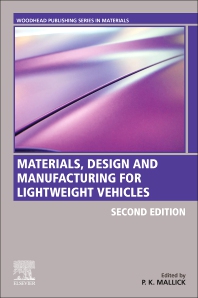Books in Production
Books in Production

Textile Waste Management
- 1st Edition
- Mohammad Shahid + 2 more
- English

Materials, Design and Manufacturing for Lightweight Vehicles
- 2nd Edition
- P.K. Mallick
- English

Computational Methods and Production Engineering
- 1st Edition
- J. Paulo Davim + 1 more
- English

Managing High-Tech Start-Ups
- 1st Edition
- Duncan MacVicar + 1 more
- English

Advances in Feature Based Manufacturing
- 1st Edition
- Volume 20
- J.J. Shah + 2 more
- English

Materials, Design and Manufacturing for Lightweight Vehicles
- 1st Edition
- P.K. Mallick
- English

Handbook of Yarn Production
- 1st Edition
- Peter R. Lord
- English

Process Planning
- 1st Edition
- Peter Scallan
- English

Handbook of Production Management Methods
- 1st Edition
- Gideon Halevi
- English

Condition Monitoring and Diagnostic Engineering Management
- 1st Edition
- A. Starr + 1 more
- English